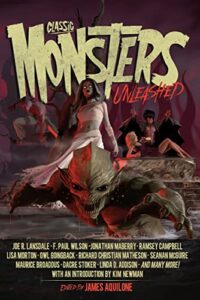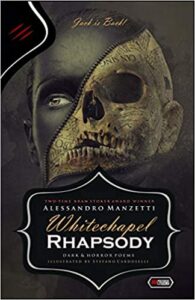Classic Monsters Unleashed edited by James Aquilone
Black Spot Books, 2022
ISBN-13: 9781645481218
Available: Kindle, Audible, paperback, hardback ( Bookshop.org | Amazon.com )
Classic Monsters Unleashed includes one poem that opens the anthology, followed by twenty-nine stories featuring, well, classic monsters. Dracula, the Invisible Man, Frankenstein, the Mummy, and the Wolf-man are included in this homage to classic monsters. The list does not end there. Nosferatu, Captain Kronos, the Headless Horseman, the Blob and more, all find space in this anthology. I have narrowed my favourites down to my top ten, but that was difficult. Each story deserves its own time in the spotlight, really.
In Jonathan Mayberry’s “Hollenlegion,” Nazis search for the allegedly abandoned island of Dr. Moreau. Simon Bestwick’s “Mummy Calls” is one of the best, and most humorous, stories in the collection. Written as a submission letter to the anthology editor, Simon explains the story of the “Manchester Mummy” and how real she actually is. Lucy A. Snyder gives us a unique story of the Phantom of the Opera meeting Jack the Ripper in “The Viscount and the Phantom.” I do not want to give anything away, so I will just leave it at that. In “Modern Monsters” by Monique Snyman, a whistleblower contacts the crew of paranormal reality show Modern Monsters to document a science experiment gone wrong. There is some body horror in this one, but not so much that it gets too gruesome. “Hacking the Horseman’s Code” by Lisa Morton is a modern day take on The Legend of Sleepy Hollow. Gil contracts a Headless Horseman AI for Halloween festivities, much to his wife’s chagrin. To mess with a political rival, he alters the AI’s programming, which backfires spectacularly. Maurice Broaddus gives us a unique vision with his “The Invisible Man: The Fire This Time.” Broaddus weaves his story through a societal racial critique that is well done and very powerful. Mercedes M. Yardley’s “The Picture of Doriana Gray” is an excellent gender-swapped take on The Picture of Dorian Gray. Crystal Sapphire, a popular social media influencer, makes a new friend who in turn influences her. In “Da Noise, Da Funk, Da Blob” by Linda D. Addison, we are presented with the Blob in a new light and Its purpose for landing on Earth. Leverett Butts and Dacre Stoker’s “Enter, the Dragon,” told through text chats, emails, YouTube transcriptions, and CCTV coverage in the shadow of COVID, tells the story of a man kidnapped by an underground group to resurrect Vlad Tepes. It’s Dracula with a dash of the X-Files. Rounding out the anthology is Joe R. Lansdale with “God of the Razor,” focusing on an antique dealer who unexpectedly meets with Jack the Ripper.
Other authors who contributed great additions to this anthology include Gary A. Braunbeck, Ramsey Campbell, JG Faherty, Geneve Flynn, Owl Goingback, Michael Knost, Alessandro Manzetti, Rena Mason, Richard Christian Matheson, Seanan McGuire, John Palisano, Lindy Ryan, Carlie St. George, David Surface, Gaby Triana, Tim Waggoner, Paul Wilson, Kelsea Yu, Sean Eads, and Joshua Viola.
I would be remiss if I did not mention the incredible artwork. Artists include Zac Atkinson, Frank Frazetta, Jeremiah Lambert, Sam Shearan, and Colton Worley.
Pick this up if you want an anthology that pays homage to both the traditional classic monsters, as well as ones that do not get much attention. Highly recommended.
Reviewed by Lizzy Walker







Follow Us!